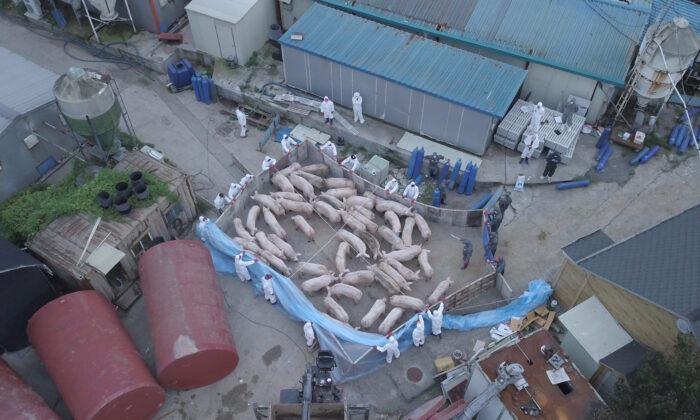The United Nation’s
reported that fourteen months since African swine fever (ASF) broke out in China’s Heilongjiang Province, the fatal disease has spread to Vietnam, Cambodia, Laos, South Korea, North Korea, Philippines, Burma, and Timor-Leste.
The UN Food and Agriculture Organization’s (FAO) latest update on China reveals that ASF, a disease that is 100 percent fatal to pigs, has spread to twenty-one provinces, four major municipalities, most of Mongolia and Inner Mongolia, Tibet, the Autonomous Regions and the Hong Kong Special Administrative Region.
Over the seven days of the Oct. 1 National Day celebrations that marked the 70th anniversary of Communist China, the Ministry of Commerce, the National Development and Reform Commission, the Ministry of Finance and other departments conducted a third
release into local markets from the national meat reserve that included 10,000 tons of frozen pork. Since Sept. 19, China has released 30,000 tons of frozen pork, 2,400 tons of beef and 1,900 tons of lamb.
FAO’s Chief Veterinary Officer Dr. Juan Lubroth
commented that with “no commercially available vaccine” against ASF expansion, he urged “at-risk countries to implement effective biosecurity measures to prevent infected live pigs or contaminated pork products from crossing their borders.”
With China’s ASF outbreaks rapidly spreading throughout Asia, Rabobank released a
report stating, “ASF is the most significant event in animal protein this year and will have implications for years to come.” Bank analysts forecast China’s swine herd losses by the end of 2019 will reach 55 percent, or about 193 million of its 350 million pigs.
Rabobank predicts: “China’s pork meat output will decline by an unprecedented 25 percent in 2019 and could result even lower in 2020: This will have effects that last into the coming years.”
Rabobank Executive Director Christine McCracken told attendees at the 2019 Leman Swine Conference that at least 75 percent of the world’s pork is at risk of contracting ASF. She
warned, “The spread of ASF in Asia underlines just how critical transboundary movement and the movement of people and pigs into other countries is.”
McCracken added: “It’s a big concern from the perspective that we still have a lot of potential points of entry at the border, not just in the U.S., but in other countries that are large, pig producing regions as well.”
She called Southeast Asia a hotbed of ASF exposure because pork is the protein of choice. Vietnam that has historically been largely self-sufficient in pork, is now suffering ASF outbreaks in every province. As ASF sweeps across the continent, it is set to bring lasting changes regarding food security needs in many Asian countries.
China’s National Bureau of Statistics reported that despite rising pork imports volumes, live pig prices are up by about 70 percent this year to
all-time highs, after doubling in September.
Rabobank forecasts further Asian pork price increases into fourth quarter, which historically has seen the strongest demand to build inventory for Chinese New Year. With already tight global supply, China, Vietnam, the Philippines, Laos, Cambodia, Burma, Timor-Leste and the Korean peninsula will be forced to compete on price for pork imports through at least 2020.
McCracken stated that the United States is well placed to increase exports of pork. Despite the trade war with China, U.S. pork exports are up 3 percent this year and the latest Hogs & Pigs Report indicates record numbers in the U.S. hog inventory.
McCracken forecasts, “it may be at least 10 years before we get back to the levels of [Asia] production that we saw coming into this.” She added, “We’re looking at a very long tail on this, that should lead to a lot of incremental demand for U.S. protein going forward.”
Chriss Street is an expert in macroeconomics, technology, and national security. He has served as CEO of several companies and is an active writer with more than 1,500 publications. He also regularly provides strategy lectures to graduate students at top Southern California universities.





